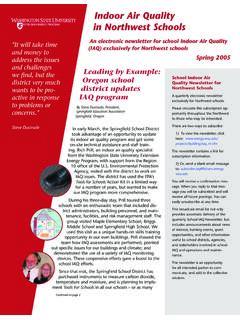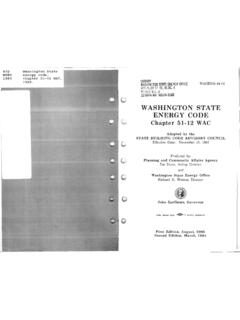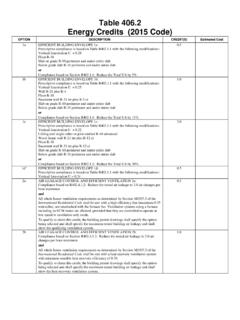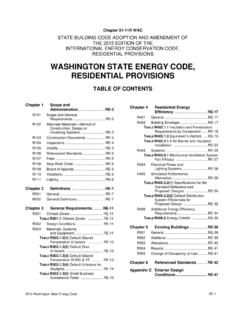Transcription of Solar Electric System Design, Operation and Installation
1 Solar Electric System design , Operation and Installation An Overview for Builders in the Pacific Northwest October 2009. Solar Electric System design , Operation and Installation An Overview for Builders in the Pacific Northwest October 2009. 2009 Washington State University Extension Energy Program 905 Plum Street SE, Bldg 3. Olympia, WA 98504-3165. This publication contains material written and produced for public distribution. Permission to copy or disseminate all or part of this material is granted, provided that the copies are not made or distributed for commercial advantage and that they are referenced by title with credit to the Washington State University Extension Energy Program. WSUEEP09-013. Acknowledgments The primary author of this overview was Carolyn Roos, , of the Washington State University Extension Energy Program. Mike Nelson of the Northwest Solar Center provided very helpful consultation and a detailed review of several drafts. Kacia Brockman of the Energy Trust of Oregon also provided very insightful review comments.
2 This publication was adapted and updated from one prepared for the Energy Trust of Oregon, Inc. in 2005. Disclaimer While the information included in this guide may be used to begin a preliminary analysis, a professional engineer and other professionals with experience in Solar photovoltaic systems should be consulted for the design of a particular project. Neither Washington State University nor its cooperating agencies, nor any of their employees, makes any warranty , express or implied, or assumes any legal liability or responsibility for the accuracy, completeness or usefulness of any information, apparatus, product, or process disclosed, or represents that its use would not infringe privately owned rights. Reference herein to any specific commercial product, process, or service by trade name, trademark, manufacturer, or otherwise does not necessarily constitute or imply its endorsement, recommendation, or favoring by Washington State University or its cooperating agencies. iii Contents Introduction.
3 1. Evaluating a Site for Solar PV 2. Photovoltaic System 5. System 8. Solar Modules .. 8. Array Mounting Racks .. 11. Grounding 12. Combiner Box .. 13. Surge 13. Meters and 13. Inverter .. 14. 16. Battery 17. Charge Controller .. 18. Putting the System Together .. 20. The Project 20. The NEC and PV Systems .. 21. Safety During the Installation .. 21. Special Considerations in Wiring PV Systems .. 22. System design 23. System Considerations .. 23. design 23. Cost Considerations .. 25. For More Information References .. 26. Acronyms and Abbreviations .. 29. List of Figures Figure 1. One common configuration of a grid-connected AC photovoltaic System without battery back-up .. 6. Figure 2. One common configuration of a grid-connected AC photovoltaic System with battery back-up .. 7. iv Introduction As the demand for Solar Electric systems grows, progressive builders are adding Solar photovoltaics (PV) as an option for their customers. This overview of Solar photovoltaic systems will give the builder a basic understanding of: Evaluating a building site for its Solar potential Common grid-connected PV System configurations and components Considerations in selecting components Considerations in design and Installation of a PV System Typical costs and the labor required to install a PV System Building and Electric code requirements Where to find more information Emphasis will be placed on information that will be useful in including a grid-connected PV System in a bid for a residential or small commercial building.
4 We will also cover those details of the technology and Installation that may be helpful in selecting subcontractors to perform the work, working with a designer, and directing work as it proceeds. A summary of System types and components is given so the builder will know what to expect to see in a design submitted by a subcontractor or PV designer. In 2008, the installed cost of a residential PV System in the United States typically ranged from $8 to $10 per installed watt before government or utility incentives. For more detail on costs, see the section titled Cost Considerations. For information on putting together your Installation team, refer to the section The Project Team.. 1. Evaluating a Site for Solar PV Potential Does the Pacific Northwest Have Good Solar Potential? This is a very common question and the answer is, yes, the Pacific Northwest gets enough sun for grid-connected photovoltaic systems to operate well. The Northwest's highest Solar potential is east of the Cascades.
5 But even west of the Cascades, the Oregon's Willamette Valley receives as much Solar energy annually as the average as much over the course of the year as southern France and more than Germany, the current leader in Solar Electric installations. Under cloudy conditions, it is true that photovoltaics produce only 5 to 30. percent of their maximum output. However, because Solar photovoltaics become less efficient when hot, our cooler climate and our long summer days help make up for the cloudy days. Evaluating a Building Site While the Pacific Northwest may have good to excellent Solar potential, not every building site will be suitable for a Solar Installation . The first step in the design of a photovoltaic System is determining if the site you are considering has good Solar potential. Some questions you should ask are: Is the Installation site free from shading by nearby trees, buildings or other obstructions? Can the PV System be oriented for good performance? Does the roof or property have enough area to accommodate the Solar array?
6 If the array will be roof-mounted, what kind of roof is it and what is its condition? Mounting Location Solar modules are usually mounted on roofs. If roof area is not available, PV modules can be pole-mounted, ground-mounted, wall-mounted or installed as part of a shade structure (refer to the section System Components/Array Mounting Racks below). Shading Photovoltaic arrays are adversely affected by shading. A well-designed PV. System needs clear and unobstructed access to the sun's rays from about 9 to 3 , throughout the year. Even small shadows, such as the shadow of a single branch of a leafless tree can significantly reduce the power output of a Solar module. 1 Shading from the building itself due to vents, attic fans, skylights, gables or overhangs must also be avoided. Keep in mind that an area may be unshaded during one part of the day, but shaded at another part of the day. Also, a site that is unshaded in the summer may be shaded in the winter due to longer winter shadows.
7 2. Orientation In northern latitudes, by conventional wisdom PV modules are ideally oriented towards true south. 3 But the tilt or orientation of a roof does not need to be 1. This is because when manufacturers assemble Solar modules from cells, they wire groups of cells in series with each other. Shading one cell will essentially turn off all the cells in its group. 2. Shading can be evaluated using tools such as the Solar Path Finder ( ). 3. Deviations between magnetic and true south, referred to as magnetic declination, vary by location. Magnetic declination changes slowly over time, so be sure to use data within the last decade or so. Obtain 2. perfect because Solar modules produce 95 percent of their full power when within 20. degrees of the sun's direction. Roofs that face east or west may also be acceptable. As an example, a due west facing rooftop Solar PV System , tilted at 20 degrees in Salem, Oregon, will produce about 88 percent as much power as one pointing true south at the same location.
8 Flat roofs work well because the PV modules can be mounted on frames and tilted up toward true south. Optimum orientation can be influenced by typical local weather patterns. For example, western Washington and Oregon frequently have a marine layer of fog that burns off by late morning and so have better Solar resource after noon than before noon. Thus, west of the Cascades, the maximum power is generated with a southwest orientation. Tilt Generally the optimum tilt of a PV array in the Pacific Northwest equals the geographic latitude minus about 15 degrees to achieve yearly maximum output of power. An increased tilt favors power output in the winter and a decreased tilt favors output in the summer. In western Washington and Oregon, with their cloudier winters, the optimum angle is less than the optimum east of the Cascades. Nevertheless, it is recommended that modules be installed at the same pitch as a sloping roof, whatever that slope is, primarily for aesthetic reasons, but also because the tilt is very forgiving.
9 In Salem, Oregon, for example, tilts from 20 degrees to 45 degrees will result in approximately the same power production over the course of the year. This is because tilts that are less than the latitude of the site increase summer production when the Solar resource is most available here, but reduce winter production when it tends to be cloudy anyway. Required Area Residential and small commercial systems require as little as 50 square feet for a small System up to as much as 1,000 square feet. As a general rule for the Pacific Northwest, every 1,000 watts of PV modules requires 100 square feet of collector area for modules using crystalline silicon (currently the most common PV cell type). Each 1,000 watts of PV modules can generate about 1,000 kilowatt-hours (kWh) per year in locations west of the Cascades and about 1,250 kWh per year east of the Cascades. When using less efficient modules, such as amorphous silicon or other thin-film types, the area will need to be approximately doubled.
10 If your location limits the physical size of your System , you may want to install a System that uses more-efficient PV modules. Keep in mind that access space around the modules can add up to 20 percent to the required area. Roof Types For roof-mounted systems, typically composition shingles are easiest to work with and slate and tile roofs are the most difficult. Nevertheless, it is possible to install PV modules on all roof types. If the roof will need replacing within 5 to 10 years, it should be replaced at the time the PV System is installed to avoid the cost of removing and reinstalling the PV System . maps of magnetic declination at In Oregon, magnetic declinations range from about 17 to 22 degrees east. 3. Building integrated PV (BIPV) modules, which can be integrated into the roof itself, might be considered for new construction or for an older roof in need of replacing. While BIPV products currently have a premium price, costs are expected to decrease. 4. Photovoltaic System Types Photovoltaic System types can be broadly classified by answers to the following questions: Will it be connected to the utility's transmission grid?









